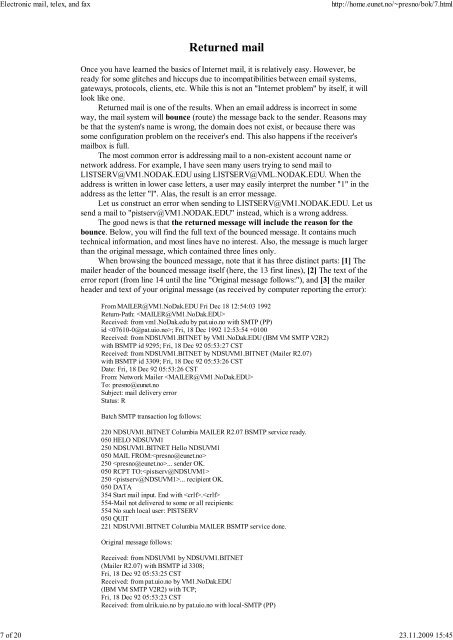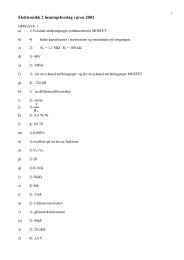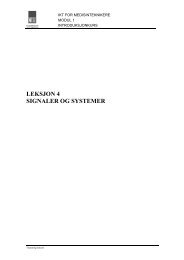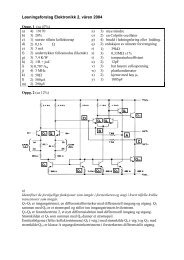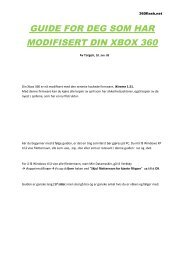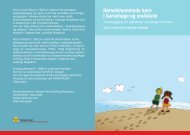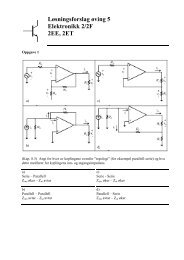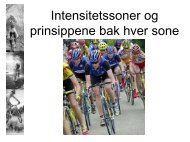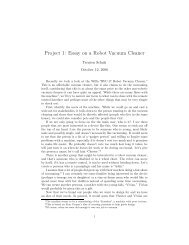The Online World resources handbook
The Online World resources handbook
The Online World resources handbook
Create successful ePaper yourself
Turn your PDF publications into a flip-book with our unique Google optimized e-Paper software.
Electronic mail, telex, and fax http://home.eunet.no/~presno/bok/7.html<br />
Returned mail<br />
Once you have learned the basics of Internet mail, it is relatively easy. However, be<br />
ready for some glitches and hiccups due to incompatibilities between email systems,<br />
gateways, protocols, clients, etc. While this is not an "Internet problem" by itself, it will<br />
look like one.<br />
Returned mail is one of the results. When an email address is incorrect in some<br />
way, the mail system will bounce (route) the message back to the sender. Reasons may<br />
be that the system's name is wrong, the domain does not exist, or because there was<br />
some configuration problem on the receiver's end. This also happens if the receiver's<br />
mailbox is full.<br />
<strong>The</strong> most common error is addressing mail to a non existent account name or<br />
network address. For example, I have seen many users trying to send mail to<br />
LISTSERV@VM1.NODAK.EDU using LISTSERV@VML.NODAK.EDU. When the<br />
address is written in lower case letters, a user may easily interpret the number "1" in the<br />
address as the letter "l". Alas, the result is an error message.<br />
Let us construct an error when sending to LISTSERV@VM1.NODAK.EDU. Let us<br />
send a mail to "pistserv@VM1.NODAK.EDU" instead, which is a wrong address.<br />
<strong>The</strong> good news is that the returned message will include the reason for the<br />
bounce. Below, you will find the full text of the bounced message. It contains much<br />
technical information, and most lines have no interest. Also, the message is much larger<br />
than the original message, which contained three lines only.<br />
When browsing the bounced message, note that it has three distinct parts: [1] <strong>The</strong><br />
mailer header of the bounced message itself (here, the 13 first lines), [2] <strong>The</strong> text of the<br />
error report (from line 14 until the line "Original message follows:"), and [3] the mailer<br />
header and text of your original message (as received by computer reporting the error):<br />
From MAILER@VM1.NoDak.EDU Fri Dec 18 12:54:03 1992<br />
Return Path: <br />
Received: from vm1.NoDak.edu by pat.uio.no with SMTP (PP)<br />
id ; Fri, 18 Dec 1992 12:53:54 +0100<br />
Received: from NDSUVM1.BITNET by VM1.NoDak.EDU (IBM VM SMTP V2R2)<br />
with BSMTP id 9295; Fri, 18 Dec 92 05:53:27 CST<br />
Received: from NDSUVM1.BITNET by NDSUVM1.BITNET (Mailer R2.07)<br />
with BSMTP id 3309; Fri, 18 Dec 92 05:53:26 CST<br />
Date: Fri, 18 Dec 92 05:53:26 CST<br />
From: Network Mailer <br />
To: presno@eunet.no<br />
Subject: mail delivery error<br />
Status: R<br />
Batch SMTP transaction log follows:<br />
220 NDSUVM1.BITNET Columbia MAILER R2.07 BSMTP service ready.<br />
050 HELO NDSUVM1<br />
250 NDSUVM1.BITNET Hello NDSUVM1<br />
050 MAIL FROM:<br />
250 ... sender OK.<br />
050 RCPT TO:<br />
250 ... recipient OK.<br />
050 DATA<br />
354 Start mail input. End with .<br />
554 Mail not delivered to some or all recipients:<br />
554 No such local user: PISTSERV<br />
050 QUIT<br />
221 NDSUVM1.BITNET Columbia MAILER BSMTP service done.<br />
Original message follows:<br />
Received: from NDSUVM1 by NDSUVM1.BITNET<br />
(Mailer R2.07) with BSMTP id 3308;<br />
Fri, 18 Dec 92 05:53:25 CST<br />
Received: from pat.uio.no by VM1.NoDak.EDU<br />
(IBM VM SMTP V2R2) with TCP;<br />
Fri, 18 Dec 92 05:53:23 CST<br />
Received: from ulrik.uio.no by pat.uio.no with local SMTP (PP)<br />
7 of 20 23.11.2009 15:45


